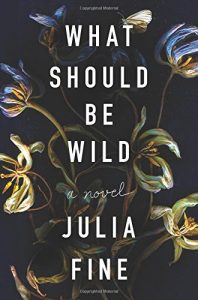 Born with the power to kill or resurrect at her slightest touch, Maisie Cothay has spent her childhood sequestered in her family’s manor at the edge of a mysterious forest. Maisie’s father has warned her not to venture into the wood lest she vanish like her female ancestors – but one day he disappears, and Maisie must venture beyond the walls of her carefully constructed life to find him. Away from her home and the wood for the very first time, she encounters a strange world filled with wonder and deception. Yet the farther she strays, the more the wood calls her home. For only there can Maisie finally reckon with her power and come to understand the wildest parts of herself.
Born with the power to kill or resurrect at her slightest touch, Maisie Cothay has spent her childhood sequestered in her family’s manor at the edge of a mysterious forest. Maisie’s father has warned her not to venture into the wood lest she vanish like her female ancestors – but one day he disappears, and Maisie must venture beyond the walls of her carefully constructed life to find him. Away from her home and the wood for the very first time, she encounters a strange world filled with wonder and deception. Yet the farther she strays, the more the wood calls her home. For only there can Maisie finally reckon with her power and come to understand the wildest parts of herself.What Should Be Wild is a dark fantasy that explores the lies we tell one another and the ones we tell ourselves, the half-truths that tug at an idea in the back of our mind we refuse to acknowledge, but that end up calling out to us in whispers anyway. The novel – centered on an only-child and her social-anthropologist father – is told in first-person when Maisie narrates her seventeenth summer and then in third when author Julia Fine focuses on the history of the Blakely women. (Maisie, it should be known, comes from a long line of “cursed” women who inhabit her home, Urizon, and then disappear into the thicket surrounding it.) Fine’s prose is lush with detail, as thick and tangled in places as the forest that encumbers on the estate. The care with which she sets up the novel’s backstory is evident in every chapter; the history of Maisie’s small, sheltered world is permanently etched into the stone and dirt and trees that both protect Urizon and also suffocate it.
I marveled at how timeless the book felt, as if it could have existed alongside the women whose lives it brought into being… perhaps because a part of Maisie exists with all of her ancestors, and they with her. She shares a wild vein that defines all Blakely women – which feels, at times, to physically encircle her ankle and drag her back into the forest. It’s the wildness that defies the Blakely name and its expectations, that marks each one of them as different or even dangerous, that keeps home in the bottom of their gut and dares to ask what if.
Fine’s novel is both the scary story we tell children to teach them fear and also the acceptance and acknowledgment of that fear. It’s a beautiful meditation on societal expectation, familial bond, and the bone-deep, almost physical desires we all have but maybe refuse to acknowledge, intricately woven into the mystery that spurs the plot. And, in a way, the book reminded me of what Grimm’s fairy tales could have been if they’d been more than just preserved medieval folklore. What Should Be Wild succeeds at acknowledging the wildness within its characters, but also letting us decide if that wildness is better left untamed.
What Should Be Wild makes me want to read all of the books set in spooky, scary woods! Here are some I’ve added to my list: The Bear and the Nightingale by Katherine Arden, The Book of Lost Things by John Connolly, The Hazel Wood by Melissa Albert, and Through the Woods by Emily Carroll.


